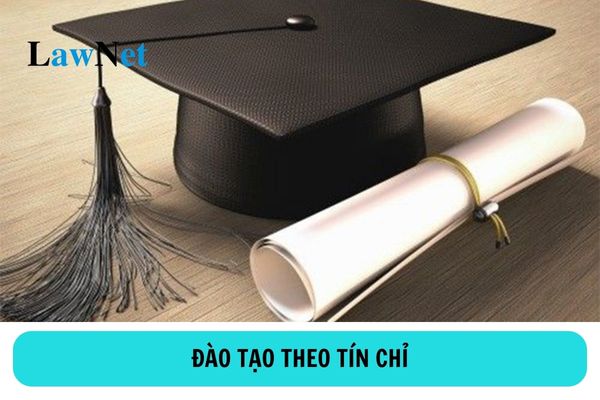What is credit-based training in Vietnam? How many minimum credits do university students need to take?
What is credit-based training in Vietnam?
According to Clause 2, Article 3 of the Regulations on university training levels issued alongside Circular 08/2021/TT-BGDDT, credit-based training is:
- A training method organized by each module class, allowing students to accumulate credits for each module and carry out the training program according to their individual study plan, in alignment with the teaching plan of the training institution;
- Students who fail a compulsory module must retake that module or take an equivalent module as prescribed in the training program, or take a substitute module if the original module is no longer offered;
- Students who fail an elective module must retake that module or may choose to take another elective module as prescribed in the training program.
Training institutions select and apply the method of credit-based training as follows:
- Apply uniformly to all courses and training forms, or;
- Apply to certain courses or specific training forms.

What is credit-based training in Vietnam? How many minimum credits do university students need to take? (Image sourced from the Internet)
How many minimum credits do university students need to take in Vietnam?
According to Clause 2, Article 7 of Circular 17/2021/TT-BGDDT regulations:
Study Load
- The study load for the training program, each component, or each module within the training program is determined by the number of credits.
a) One credit is equivalent to 50 hours of standard study time for the student, including time spent attending lectures, guided study hours, self-study, research, experimentation, and assessments;
b) For classroom teaching activities, one credit requires a minimum of 15 lecture hours or 30 hours of practice, experimentation, discussion in which one class hour is calculated as 50 minutes.
2. The minimum study load of a training program must align with the requirements of the Vietnam National Qualifications Framework. To be specific:
a) Undergraduate programs: 120 credits, plus physical education, national defense, and security education credits as per current regulations;
b) Specialized training programs at level 7: 150 credits, plus physical education, national defense, and security education credits as per current regulations; or 30 credits for those with a bachelor's degree in a related field;
c) Master's programs: 60 credits for those with a bachelor's degree in a related field;
d) Doctoral programs: 90 credits for those with a master's degree, 120 credits for those with a bachelor's degree in a related field.
- The minimum study load for double-major programs must add 30 credits, for major-minor programs must add 15 credits compared to equivalent single-major programs.
According to the regulations, the minimum study load for an undergraduate program is 120 credits, plus physical education, national defense, and security education credits as per current regulations.
Thus, university students must complete a minimum of 120 credits, not including physical education, national defense, and security education credits.
How many insufficient credits in a main semester will result in a student being placed under academic warning in Vietnam?
According to Clause 1, Article 11 of the Regulations on university training levels issued alongside Circular 08/2021/TT-BGDDT, the regulations state:
Handling study results by credit
- At the end of each main semester, students are placed under academic warning based on several conditions as follows:
a) The total number of credits not achieved in the semester exceeds 50% of the registered study load, or the total number of outstanding credits from the beginning of the course exceeds 24 credits;
b) The semester GPA is below 0.8 for the first semester of the course, below 1.0 for subsequent semesters;
c) The cumulative GPA is below 1.2 for first-year students, below 1.4 for second-year students, below 1.6 for third-year students, and below 1.8 for students in subsequent years.
- Students are expelled in the following cases:
a) The number of academic warnings or the level of academic warnings exceeds the limits as stipulated by the training institution;
b) The period of study exceeds the time limit as prescribed in Clause 5, Article 2 of these Regulations.
- The training institution's regulations shall specify:
a) The application of certain conditions for academic warnings, the limit on the number of times or levels of academic warnings but not exceeding 2 consecutive warnings;
b) Procedures and processes for academic warnings and expulsion; notification of the form of application to students;
c) The retention of accumulated study results in the event of a student being expelled.
Thus, in the case of credit-based training, a student whose total number of insufficient credits in a main semester exceeds 50% of the registered study load will be placed under academic warning.


- What are the sample essays on sharing an experience with a family member for 6th-grade students in Vietnam? What elective subjects do 6th-grade students learn?
- Vietnam: What is Polymer? What is the grade at which the Chemistry curriculum covers Polymer?
- Vietnam: What are the sample social argumentative essays on artificial intelligence? What is the grade at which students initially write social argumentative essays?
- Vietnam: What are the sample discussions on students being late for school? What are the criteria for text corpus used in the 9th-grade Literature curriculum?
- Vietnam: When was the directive on national resistance given? What education level does 9th Grade fall under?
- Vietnam: What is the overview of industrial revolutions over periods in the 10th-grade History curriculum? What knowledge about industrial revolutions do 10th-grade students learn?
- What is the Plan for organizing professional training for English teachers in Ho Chi Minh City about?
- Vietnam: What are the sample outlines of a social argumentative essay on kindness for 9th-grade students? What are the kindness qualities required for 9th-grade students?
- Vietnam: What are the sample argumentative essays on respecting people's differences for 11th-grade students? What are the conditions for 11th-grade students to be eligible for grade advancement?
- Are students pursuing dance in Vietnam eligible for tuition reduction?

